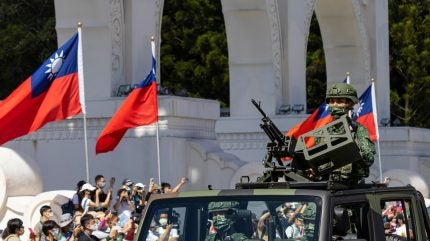
With mounting incursions by China’s PLA, Taiwan is boosting its defence capabilities.
This includes acquiring fighter jets, main battle tanks, and naval vessels, emphasising its commitment to sovereignty and regional stability.
In response to the increasing military provocations from China, Taiwan is modernising its armed forces with a focus on its Army, Air Force, and Navy. This overhaul, fuelled by a defence budget increase, aims to counter the threats posed by the People’s Liberation Army (PLA) and ensure Taiwan’s security and autonomy.
According to GlobalData’s “Taiwan Defense Market 2024-2029” report, Taiwan’s defence budget is projected to grow from $19.4bn (T$636.5bn) in 2024 to $23.4bn (T$767.8bn) by 2029. This financial commitment reflects the urgent need to enhance Taiwan’s defensive capabilities amid China’s frequent military drills near its airspace and territorial waters.
Bolstering aerial combat
Taiwan’s defence revamp is led by the Air Force, which is set to receive 56 F-16V Block 70/72 Viper aircraft. These jets are an upgrade from older models. By 2026, Taiwan plans to operate a fleet of 208 F-16s, a move designed to solidify its aerial combat and serve as a deterrent against Chinese air incursions.
In June this year, the US approved a $220m sale of F-16 spare and repair parts to Taiwan, highlighting ongoing US support for Taiwan.
China has suspended arms control and non-proliferation talks with the US, blaming Washington’s continued arms sales to Taiwan for escalating tensions. This move follows the US State Department’s recent approval of a $360m sale of loitering munitions to Taiwan, including Switchblade and ALTIUS systems.
Reinforcing ground defences
On the ground, Taiwan is enhancing its Army with 108 M1A2 Abrams main battle tanks from the United States. This $1.4bn contract includes training for Taiwanese forces, ensuring operational readiness. The Abrams tanks are critical in maintaining a ground force capable of responding to any PLA aggression.
Expanding maritime capabilities
Taiwan’s Navy is also undergoing upgrades. A significant component of this modernisation is the construction of ten new 2,500-ton light frigates by Jong Shyn Shipbuilding. These vessels, along with the addition of MH-60R Seahawk helicopters from the United States, will improve Taiwan’s anti-surface and anti-submarine warfare capabilities. Moreover, the Hai Kun-class Indigenous Defense Submarine launch, part of a $12.3bn programme, marks an enhancement in Taiwan’s underwater surveillance and combat strength.
Self-reliance and regional stability
These military enhancements are part of Taiwan’s strategy to achieve self-reliance in defence. Under the National Defense Industry Development Act, Taiwan actively encourages domestic companies to participate in the defence sector, aiming to reduce dependency on foreign suppliers and build an indigenous defence industry. This initiative is important as Taiwan navigates its complex political landscape and seeks to maintain regional stability.
Taiwan’s military modernisation efforts highlight its resolve to defend its sovereignty against escalating threats from China. The investments in aircraft, main battle tanks, and naval vessels are pivotal in enhancing its defence posture and maintaining peace in a region marked by increasing geopolitical tension. For a detailed analysis of Taiwan’s defence strategies and future procurement plans, refer to GlobalData’s “Taiwan Defense Market 2024-2029” report.




